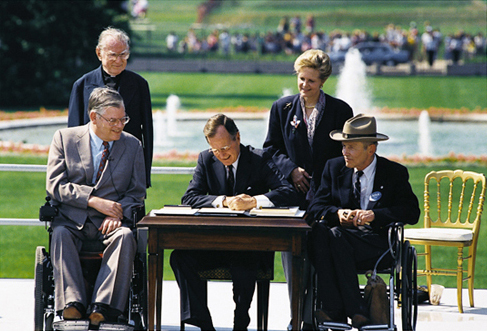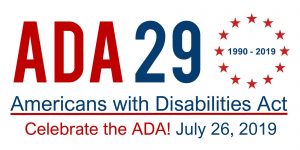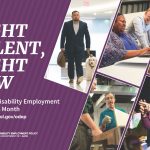
In 1990, President H.W. Bush signed ADA into law
Just over a half century ago marked the passing of the landmark Civil Rights Act of 1964, amended by Section 504 of the Rehabilitation Act. Twenty-five years later and 27 years ago, the Americans with Disabilities Act (ADA) passed with bipartisan support in both chambers of Congress and was signed into law by President George H.W. Bush. The date was July 26, 1990. The title sheet of the document read “An Act: To establish a clear and comprehensive prohibition of discrimination on the basis of disability.”
According to the federal government, ADA “…prohibits discrimination and guarantees that people with disabilities have the same opportunities as everyone else to participate in the mainstream of American life.” Specifically, ADA:
- Forbids discrimination in employment on the basis of any disability
- Requires full access to government facilities and services, including public transportation
- Full access to all places of public accommodation, including commercial establishments
- The ability to use all forms of telecommunications technology.
ADA also sets standards on accessibility, for example wheelchair ramps, entrances, and playgrounds.
ADA gained strength in 1999, after a Supreme Court case, Olmstead v. L.C., ruled that people with mental illness have a disability. Often known simply as “Olmstead,” the law states that people with cognitive disabilities have the right to live in least-restrictive setting, often community residences, rather than state-mandated institutions.
Let’s Celebrate!

This year, 2019, marks the 29th anniversary of the Americans with Disabilities Act. People across the U.S. are not only reflecting on progress since then, but also ensuring these rights are expanded.
In 2000 and 2001, the Smithsonian National Museum of American History hosted an interactive exhibit, “The Disability Rights Movement.” The exhibit documented civil protest to raise awareness, the right of self-determination and autonomy; parent activism and advocacy, the role of technology (in communication, mobility) in ensuring full access for people with disabilities, how children with disabilities have been treated over the years, and how the ADA set out to guarantee those rights people had been fighting for.
A Brief Look in Time
For the first 150 years of U.S. history, life for most people with disabilities was fraught with misery and challenges. Most people with cognitive disabilities were consigned to state institutions for their entire lives. In 1887, a pioneering investigative reporter named Nelly Bly wrote Ten Days in a Mad-House, exposing the horrors of these asylums. People like Helen Keller were the exception! In 1899, a lady named Elizabeth Farrell left her comfortable life in Utica, NY, to travel to the slums in New York’s Lower East Side. There, she established the Henry Street School, teaching children with severe disabilities practical skills. Her tireless advocacy would form the foundations of the special-education laws of today.
Disability rights in employment in the U.S. go back to 1920, when President Woodrow Wilson signed the Smith-Fess Act, which provided for World War I veterans disabled in action. However, this was also the time of the eugenics movement—forced sterilization prevented “feebleminded, insane, depressed, mentally handicapped, and epileptic people” from having children. The Fair Labor Standards Act of 1938 called for sheltered workshops for all people with disabilities, not just the blind. Yet, there was still a need for a law offering access to all people with disabilities to all aspects of life. Former Iowa Senator Tom Harkin set out to correct that when he authored ADA.
However, more than two-thirds of American adults with disabilities are still “striving to work,” according to a national employment survey. Disability advocates are trying to change that, in their effort to fulfill the promise of ADA.
Disability Rights Through Self-Advocacy

Disability Rights are Civil Rights
Independence is the goal for working with children and adults with disabilities, whether as a social-service agency like Advancing Opportunities (where it is an integral part of our mission and credo) or in special-education teaching. And more and more, independence also entails self-advocacy. Earlier this month, July 17 through 21, there was National Disability Voter Registration Week. This effort will continue though the November elections, to ensure that candidates for office and elected officials are engaged in promoting the rights and interests of people with all disabilities. We covered this week and its associated REV UP! campaign in an earlier article in this space.
Through civil rights legislation, awareness, and self-advocacy, there has been considerable efforts in ensuring that society respects the needs and rights of all citizens with disability. This progress will continue.
ADA in Politics: VOTE!
 While ADA29 is a time for reflection, disability advocates and self-advocates are looking ahead to the 2020 election. An ever-greater numbers are doing just that. One commentator said that a “sharply increasing number of voters with disabilities may influence 2020 election.” That translates to 2.35 million voters nationwide. A study at the Rutgers Program for Disability Research this year found that already people with disabilities are a powerful voting bloc. Using census data, the Rutgers report found that, across the U.S., voting among people with disabilities grew by 8.5 points from 2014 to 2018. New Jersey had an even bigger percentage.
While ADA29 is a time for reflection, disability advocates and self-advocates are looking ahead to the 2020 election. An ever-greater numbers are doing just that. One commentator said that a “sharply increasing number of voters with disabilities may influence 2020 election.” That translates to 2.35 million voters nationwide. A study at the Rutgers Program for Disability Research this year found that already people with disabilities are a powerful voting bloc. Using census data, the Rutgers report found that, across the U.S., voting among people with disabilities grew by 8.5 points from 2014 to 2018. New Jersey had an even bigger percentage.
Dr. Paul Aronsohn, New Jersey Ombudsman for people with disabilities urged candidates for all offices take time to address those with disabilities. At the same time, New Jersey Governor Phil Murphy urged the current presidential contenders to “take time to address those with disabilities.”
And, July 15–19, 2019, was National Disability Voter Registration Week. http://bit.ly/2YkHvbC In other words, people with disabilities and their allies continue the activism that led to ADA. And they vote!


